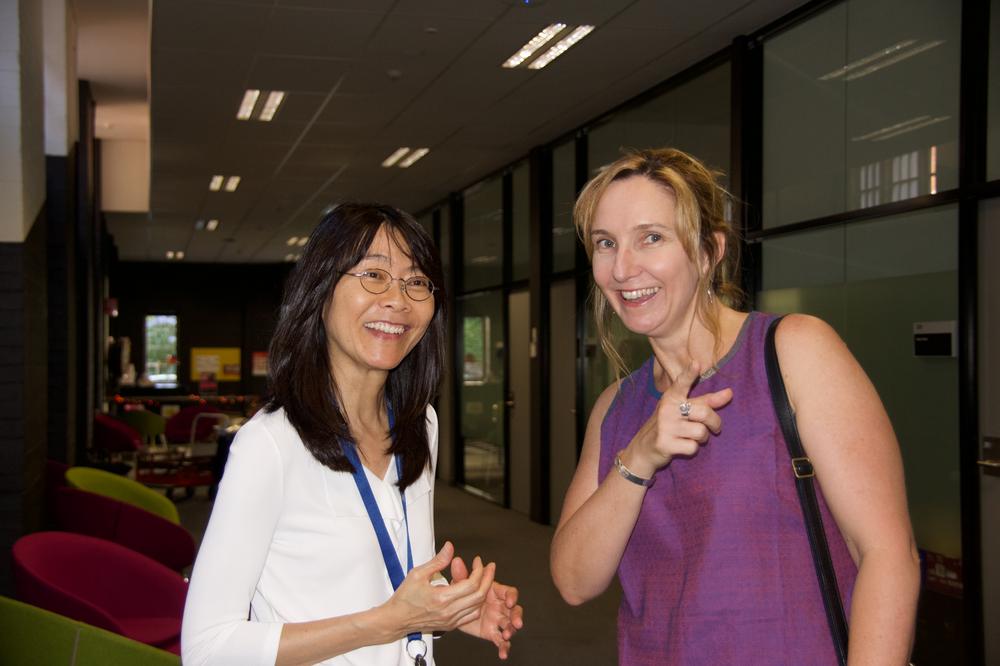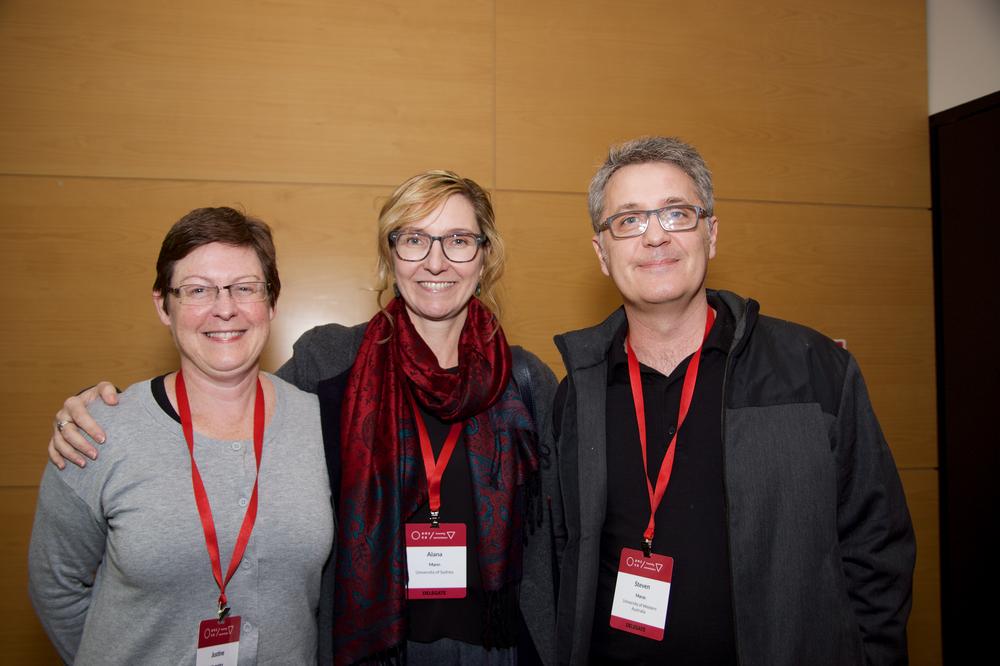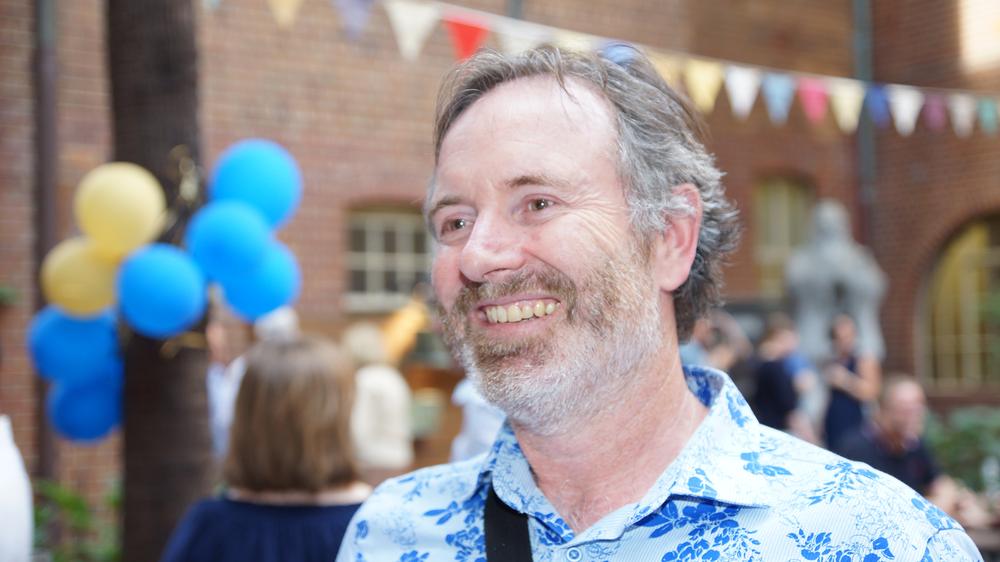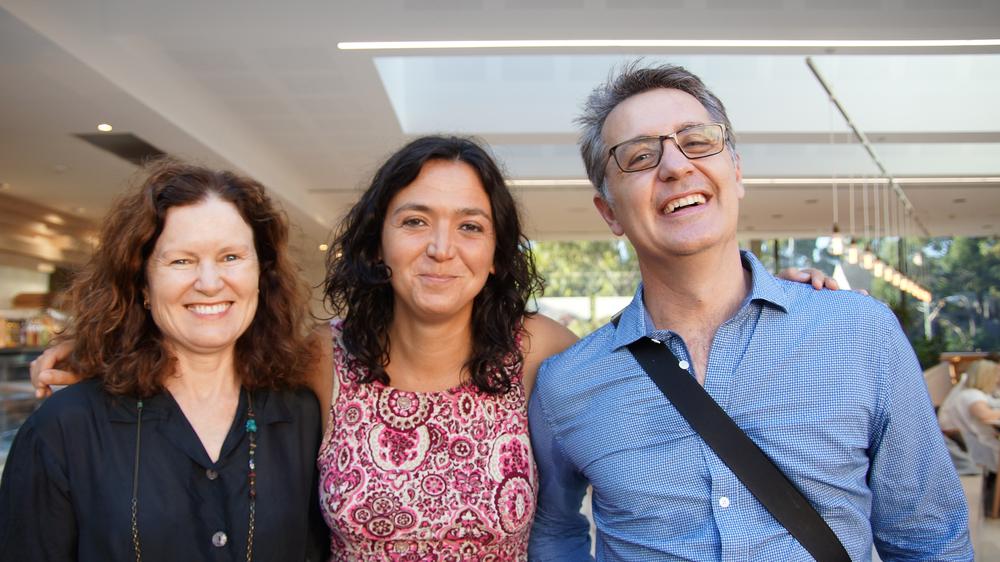3
Navigating growth and change: MECO from 2014 to 2022
Navigating growth and change
The second MECO decade saw a growing internationalisation of the curriculum, which increasingly emphasised digitalisation, interdisciplinarity and industry collaborations. Above all, there was a huge growth in student numbers, especially postgraduate, and an associated expansion of staff.
Until the beginning of 2012, student numbers and university funding were regulated by government-imposed caps on enrolments. The move to the demand driven system was one factor that influenced the growth in MECO’s student numbers. The MECO degree offerings tapped into a demand for greater knowledge and skills in new media technologies. But with climbing student numbers, it was becoming difficult to provide sufficient production spaces, labs, studios and offices for teaching staff. This lack of adequate space was exacerbated in these years.
“It was an exciting time in the department,” Alana Mann said. “We were growing really fast and we never had enough room for our staff so we all had to move offices a couple of times.”
Responding to this growth in 2014, the department changed location on campus. Moving into the John Woolley Building was an important moment in MECO history. It was also regarded as an achievement: after years of being scattered across campus with difficulties accessing proper spacing and resources, MECO could finally settle down.
It’s no surprise, then, that when we interviewed staff who were involved in MECO at this time, they all gave similar responses. In answer to our first question – “What do you think is the biggest challenge MECO has faced from 2014 until now?” – everyone mentioned the increase in student numbers.
“Incredible growth in enrolment, incredible success, almost too much success for us to handle; just overwhelming,” Mann said. The number of full-time MECO students grew over 90 percent between 2014 and 2020. During the same period, the overall number of students at the University of Sydney grew by more than 42 percent.
Bunty Avieson recalled: “Because we had so many students, there was a lot of pressure on the teaching.” A senior lecturer in journalism and media, Avieson started teaching in 2015 – news writing at postgraduate level and literary journalism and media theory at undergraduate level – while also taking care of the student internship project.
The staff we interviewed mentioned other challenges too, identifying four key factors that brought significant change: internationalisation, digitisation, interdisciplinarity and industry collaboration.
Internationalisation
The internationalisation of MECO took place over time as the department participated in international collaborations and events with academics from other universities. The department also made efforts to attract scholars with international backgrounds to join MECO and more globally oriented subjects were taught as part of the curriculum.
When Fiona Martin arrived in 2008, approximately 5 percent of the undergraduate MECO cohort was made up of international students. By 2023, it was roughly 30 percent. The growth in international student enrolments was even greater in the master’s programs. “Seeing the expansion, particularly of the Chinese international student cohort, was amazing,” Martin said. “And it certainly really challenged us to think about how we could work better with students from different cultural backgrounds.”
Lecturers needed to figure out how to teach a cohort of students who had not come through the Australian high school experience, and so had different cultural expectations of higher education. They had to consider, for example, the impacts of students growing up with the Confucian system, which focuses more on mastery through memorisation, standard tests and the respect for teachers as experts, and places less emphasis on cultivating self-directed learning, independent argument and critical thinking.
Internationalisation of higher education in Australia, and worldwide, has evolved rapidly over the past two decades, driven in part by competition in the higher education sector, global flows of students, and increased international opportunities for academic research collaborations and teaching exchanges. Initially, internationalisation at the University of Sydney took the form of scholarships for international students, study abroad exchanges and the introduction of international studies curricula. More recently, the focus has switched to international research collaborations, strategic partnerships, and more inclusive and diverse learning cultures. In 2018, the Academic Board endorsed “cultural competence” – defined as the ability to engage ethically, respectfully and successfully in intercultural settings – as one of nine specific skills graduates will emerge with at the end of their degree.
Margaret Van Heekeren, who joined MECO as a lecturer in 2017, noted that “The increase in international students has had a positive impact in ensuring that content isn’t too Australia-centric. Whilst it is important to have a predominant Australian focus, given the degree is based in Australia, having larger numbers of international students is a great reminder, when preparing content, of inclusivity.”
The MECO department now teaches a modern and globalised curriculum, but Penny O’Donnell remembers when the curriculum looked very different. O’Donnell first came to MECO in 2008 as a senior lecturer in international media and journalism, and has had a significant role in shaping MECO courses for over a decade. She was tasked with teaching theoretical subjects, while expanding them to have an international focus that examined the global media landscape. At the time, there wasn’t much comparative media research within a global context and she remembers the field as being “old-fashioned”. Comparative media research was largely based on a book published in 1956, Four theories of the press, which divided the world into authoritarian, libertarian, social responsibility and Soviet communist media.
There were only 12 units of study on offer for those studying a bachelor’s degree in MECO, with only one subject looking at media in an international context – MECO3605: Media Globalisation. “The unit focused on global market forces such as cheap labour in developing countries and environmental issues rather than the complex differences between media landscapes in different countries,” O’Donnell said.
O’Donnell realised she also had to adapt the curriculum for postgraduate international students, since they made up the major cohort of enrolments. MECO6926: International Media Practice became a core unit in the postgraduate curriculum and the University now offers several subjects focused on global media landscapes, including USSC6920: US Media: Politics, Culture, Technology; MECO6929: Chinese Media Studies; and ASNS6908: Media Industries in East Asia.
“[International students] don’t necessarily come to the University of Sydney to learn about Australian media,” she said. “They come to learn about the media and most media these days is understood as global.”
In the Master of Media Practice (Chapter 9), the international student cohort is extremely high – up to 90 percent in O’Donnell’s experience. She considers the pool of international students a precious resource when teaching in classrooms, especially with her emphasis on media diversity.
“For me as a lecturer in international media and journalism, it’s just like heaven because you’re teaching international media with international students,” O’Donnell said.
Digitalisation
Digitalisation of media industries, with the rise of digital media platforms, has been another big trend over the last decade. “That’s been challenging for everyone because it has moved so fast,” Martin said.
The merger of MECO and Digital Cultures (DC) into a single department in 2013 (see Chapter 4) stimulated research into digital technologies, though a number of MECO academics were working on digital technologies and cultures well before the merger with DC. The merger has also facilitated an expansion in the teaching of new technologies in the MECO program.
Martin noted that podcasts have become an increasingly popular student choice, evidenced by the growth in popularity of MECO6941: Podcasting. The 2022 launch of a podcast research centre, HIP: Hub for Innovation in Podcasting, reflects the direction and needs of MECO’s third decade. In addition to Martin, the podcast centre team includes Siobhán McHugh (MECO), Lea Redfern (MECO), Mark Pesce (honorary associate in Digital Cultures), Amanda Tattersall (Sydney Policy Lab and School of Geosciences), and Mim Fox (University of Wollongong). In the same year, Mark Ledbury, director of the Power Institute, pitched a new centre for visual communications, and the podcast team aims to contribute to this centre by focusing on the audio aspect of visual communications.
“When I asked students about five years ago how many wanted to go into journalism, I think we were down to about 12 percent,” Martin said. “That was five years ago so it’s probably even lower now. We still have students that go into journalism careers [but] I think there is far more interest in things like digital influence work and community management. I think there’s a heavier focus on visual media.”
While the journalism skills of writing, interviewing, research and analysis are crucial for every media graduate, the dynamic media landscape has called for new media skills. Over the past decade, MECO has introduced units to teach social media, using data to tell stories and working with online platforms.
“What employers need from university graduates has changed. Some of them welcome media students because it doesn’t matter what business or company they are, they have to engage with the media. They have to understand how to work with the media because it’s just so ubiquitous. Media is so much a part of every day,” Martin said.
Interdisciplinarity
Over the past decade, MECO has become more interdisciplinary, not just with digital cultures but also working with colleagues in political science, the China Study Centre and other disciplines. “I’ve worked with the US Study Centre as well. We’ve become more and better networked into other faculties. We’ve done stuff with Law and Medicine for example,” Martin said. “There’s been a push across the sector to be more interdisciplinary because we know that interdisciplinary research is more effective.”
Martin was among the seven writers, including Gerard Goggin, Ariadne Vromen and Kim Weatherall, of Digital rights in Australia, a 2017 report.1 “That was basically myself from a strong media studies background, Gerard from a strong internet and media telcos background, Ariadne from political science and Kim from law. What it enables us to do is use our different lenses to highlight the problems that overlap and how we can solve these, so it’s a great problem-solving strategy,” she said.
Another benefit of interdisciplinarity, according to Martin, is that MECO has become a stronger research group. “Before we were an autonomous and quite eclectic group of researchers. We had a much stronger focus on written research. I think we are a much more collaborative, more multimodal group of researchers than we were.”
“When I first came, we were a young department. We’d only been around for 10 years and were all quite junior, apart from a couple of people. During the last decade we have really ramped up our research capacity. We’ve won more ARC research grants; we have a much stronger HDR program, more coherent and better run [see Chapter 16]. Thanks to Jonathan [Hutchinson] and Bene [Brevini] for that. Now we’ll have three professors and hopefully more into the future. I’d love to see us have a professor of Indigenous media studies.”
Avieson shares that view: “Now we have people that are researching climate communications, food security, labour practices of journalists, the internet, global media, intermediation and so on. When we do get the opportunities to share our research with each other, then you find that’s fabulous.”
In 2017, the Sydney Research Excellence Initiative – SREI 2020 – was created. The new program aimed to help University researchers test new ideas, push disciplinary boundaries and identify ways to scale up their research. Exploring digital rights and governance in Australia and Asia, led by Gerard Goggin, became an important part of the project.
Industry collaboration
Another major change since 2015 has been an increased focus on working with industry and holding more public forums and debates. Martin identifies O’Donnell’s New Beats project, which examines job loss in journalism around the world, as one important example of this.
“I think that doing industry-linked research has become more important and will do into the future.” Martin also cites work her team did with Facebook on mitigating hate speech and the work that Hutchinson and colleagues are doing with Instagram as examples of industry-linked research.
Building on MECO’s links to industry at the faculty level, Martin has been leading the Work-Integrated Learning (WIL) Project. WIL is not only about getting students ready for the workplace, but also helping them in starting a business, inventing things, volunteering or undertaking further research. As Martin explained, the idea is to provide students with “more strategic and inclusive opportunities for experiential learning, and to develop more applied professional contexts for students to demonstrate key graduate capacities such as cultural competence, inventiveness and ethical responsibility.”
The present
In March 2020, the University of Sydney directed its staff to work from home in response to the COVID-19 pandemic (see Chapter 19). Student enrolment numbers did not drop dramatically as feared but online Zoom classes replaced on-campus engagement. The restrictions imposed due to COVID-19 particularly affected MECO’s production-based units teaching hands-on skills. Closed borders for most of 2020 and 2021 temporarily stemmed the flow of international students into Australia, a trend that changed once borders reopened. After two years of online classes, much of the teaching has moved back to campus.
The pandemic also affected research productivity in the department, as academic staff had to cope with increased teaching load, additional caring responsibilities at home during lockdowns and inability to pursue field work and travel.
In 2021, Catharine Lumby returned to MECO and became chair. The same year, MECO also welcomed Terry Flew, who moved to Sydney from the Creative Industries Faculty at Queensland University of Technology, Brisbane.
The year 2022 brought significant change. Alana Mann left for the University of Tasmania. On 1 August 2022, the Department of Media and Communications became a discipline within the new School of Art, Communication and English. There were 34 continuing academic staff and 216 sessional lecturers teaching across three undergraduate degrees: Bachelor of Arts/Bachelor of Advanced Studies (Digital Cultures), Bachelor of Arts/Bachelor of Advanced Studies (Media and Communications), and Bachelor of Arts and Bachelor of Laws (Major in Media Studies), with 1,657 undergraduate students (across the major and minor programs, advanced coursework and honours). There were 1,181 students across five postgraduate coursework degrees ( Master of Media Practice, Master of Strategic Public Relations, Master of Publishing, Master of Health Communication and Master of Digital Communication and Culture). There were 28 students enrolled in higher degree research.
Looking to the future, Martin is urging the University to respond to the needs for digital infrastructure at MECO. “It has been problematic for staff but equally for students to be across certain technologies,” she said, adding that “staff are feeling they are lagging in teaching, lagging in capacity to deliver that workplace-ready environment we’ve addressed in the last two or three years.” However, she has welcomed the appointment of more permanent staff as a godsend. In 2022, Agata Mrva-Montoya, Catherine Page Jeffery, Joanne Gray, John Hartley, Margie Borschke and Xiang Reng joined MECO. Gerard Goggin returned from his three-year appointment at the Wee Kim Wee School of Communication and Information at the Nanyang Technological University, Singapore. More staff followed in 2023, with Meizi Su and Ben Egliston joining the team.
In 2023, the postgraduate degrees have been reviewed as part of a Faculty of Arts and Social Science-wide process looking at the strategic purpose, curricular coherence and sustainability of the faculty’s overall portfolio of postgraduate coursework offerings. It has also been an exciting year for research, with Terry Flew being awarded an Australian Laureate Fellowship for his project Mediated Trust: Ideas, Interests, Institutions, Futures. Moreover, in September 2023, Olga Boichak and Ben Egliston were awarded two prestigious Australian Research Council Discovery Early Career Researcher Awards.
No doubt, the evolving nature of digital technology and society will continue to shape the discipline for years to come (see Chapter 20). MECO will continue to be an exciting and dynamic area of research and practice.
1 Read more at https://papers.ssrn.com/sol3/papers.cfm?abstract_id=3090774.



